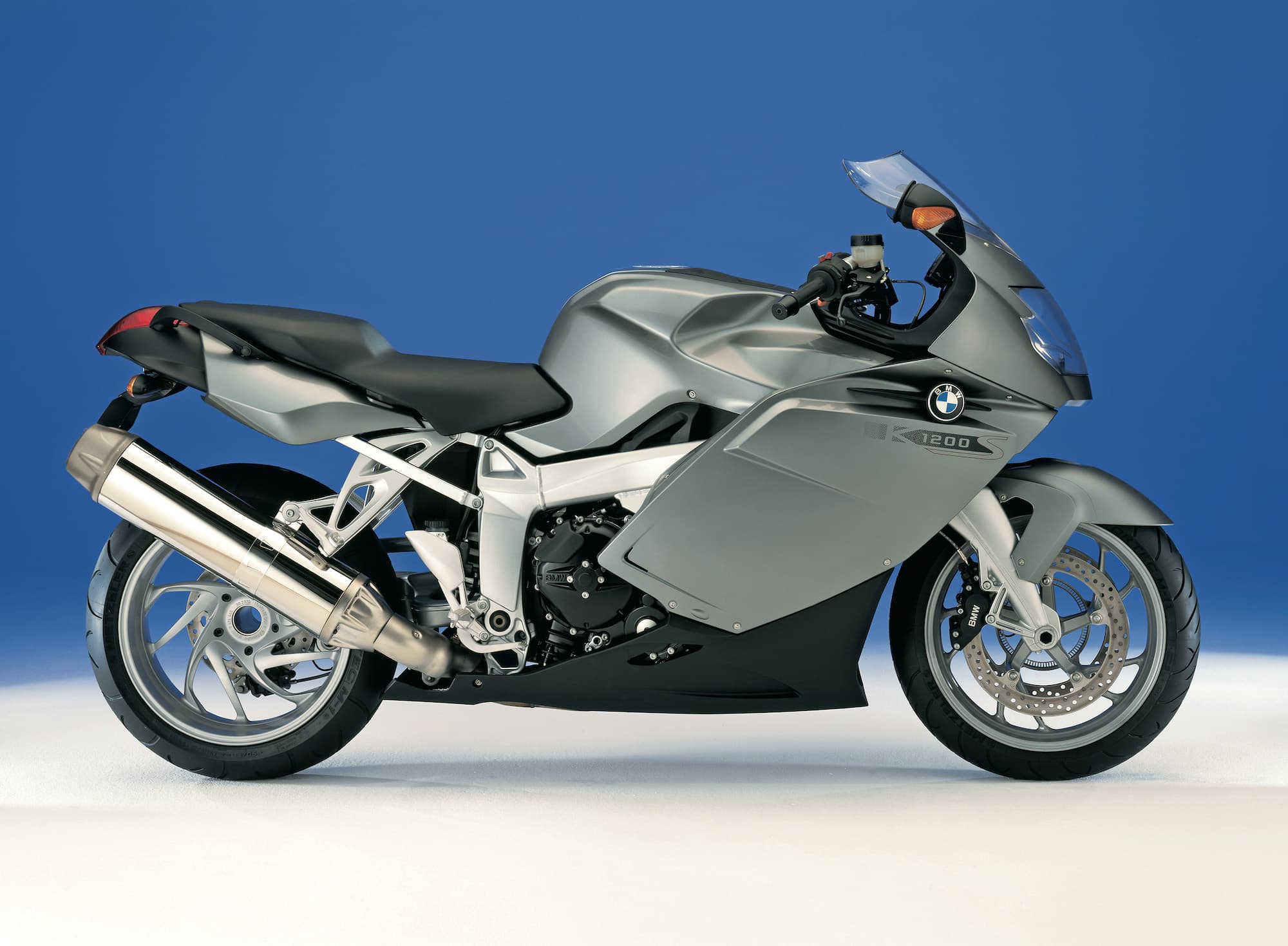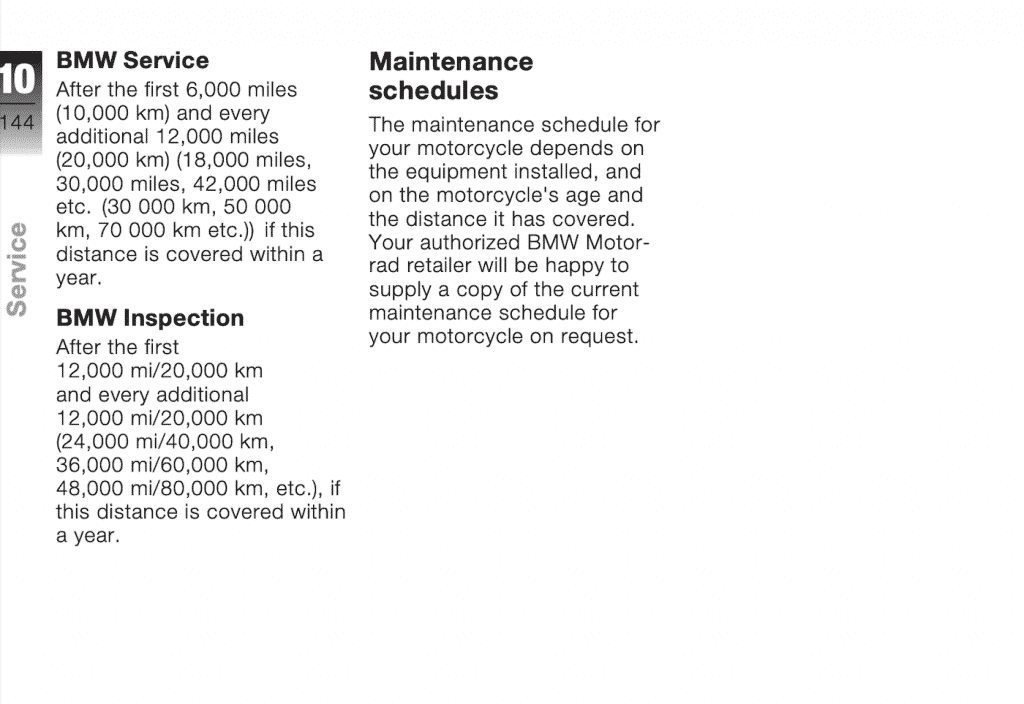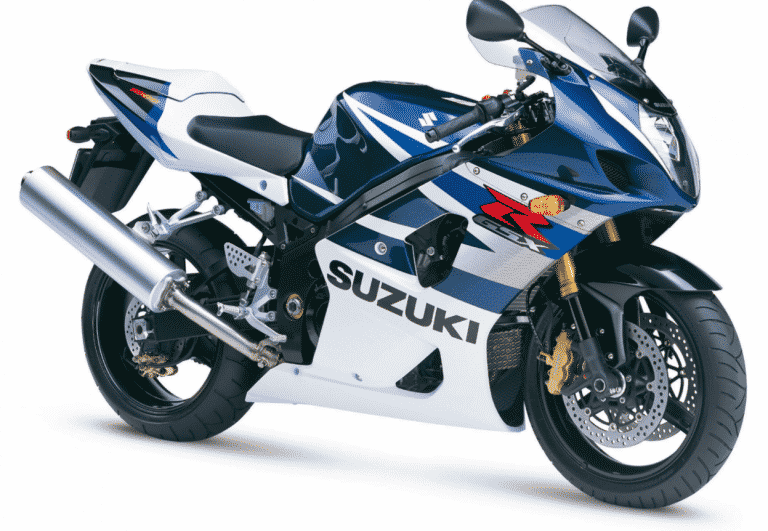BMW K 1200 S Maintenance Schedule (2004-2006)
This is the maintenance schedule and service intervals for the BMW K 1200 S, sourced from the RSD and compared with the manual.
The BMW K 1200 S is a high-capacity sports tourer from BMW. It’s based on an 1157cc liquid-cooled fuel-injected inline four-cylinder engine with four valves per cylinder and dual overhead cams. It’s quite powerful, with peak power of 123 kW (167 hp) at 10250 rpm, and with peak torque of 130 Nm (96 ft-lb) at 8250 rpm, pulling a weight of 248 kg (DIN unladen).
The BMW K 1200 S was succeeded by the K 1300 S, the last sporting bike in the K line.
This post has been considerably updated since the first version in 2021.
This site has links for things like oil and spark plugs from which we earn a commission (which unfortunately nobody can save, not even us). If you appreciate this work, then please use those links. Thanks!
BMW K 1200 S Service Intervals
The BMW K 1200 S has a minor general maintenance every 10000 km (6000 mi) in which you have to change the oil and do a general check-over of the bike.
Every 30000 km (18000 mi) you do a major service, changing the spark plugs and inspecting the valve clearances.
Owners of the BMW K 1200 S say that valve clearance adjustments are rare, especially after the first main service.
Since the K 1200 S has a liquid-cooled engine, you do have to replace the coolant periodically — every four years per the RSD.

What you need to service the BMW K 1200 S
You need the following consumables to do a basic service on your BMW K 1200 S.
| Part | BMW K 1200 S spec |
|---|---|
| Engine oil | BMW recommends Castrol GPS 10W-40 engine oil or another engine oil that meets API SG and JASO MA grades. |
| Oil filter | Part number is 83 21 2 365 958. You can also use a HF160RC as an easier-to-replace high-quality upgrade. |
| Spark plugs | The official replacement spark plug is a KR9CI. |
| Air filter | The part number for the air filter is 13 71 7 703 583. You can also use a K&N BM-1205. |
| Brake fluid | Use BMW DOT 4 brake fluid. |
| Rear wheel drive oil | SAE 75W-90 final drive oil, e.g. Castrol 75W-90 |
| Coolant | Use BMW Coolant, which is based on ethylene glycol. |
| Front brake pads | 34 11 8 534 183 for the OEM part. You can also use EBC brake pads, part FA335HH. |
| Rear brake pads | 34 21 8 541 388 for the OEM. You can also use an EBC brake pad at the rear, FA671HH. |
Maintenance schedule for the BMW K 1200 S
Below is the maintenance schedule for the BMW K 1200 S.
We’ve broken the service schedule into two parts
- The maintenance schedule of infrequent but major items
- The regular annual service checklist.
Maintenance schedule
Follow the below maintenance schedule for the BMW K 1200 S. Observe the earlier of time-based or distance-based service intervals.
| mi x 1000 | 6 | 12 | 18 | 24 | 30 | 36 | |
|---|---|---|---|---|---|---|---|
| km x 1000 | 10 | 20 | 30 | 40 | 50 | 60 | Every |
| Annual service checklist (see below) — Perform | ✓ | ✓ | ✓ | ✓ | ✓ | ✓ | Year |
| Engine oil — Change | ✓ | ✓ | ✓ | ✓ | ✓ | ✓ | |
| Oil filter — Change | ✓ | ✓ | ✓ | ✓ | ✓ | ✓ | |
| Spark plugs — Replace | ✓ | ✓ | |||||
| Valve clearances — Check / adjust | ✓ | ✓ | |||||
| Air filter — Change | ✓ | ||||||
| Rear wheel drive — Change oil | 2 years | ||||||
| Brake fluid — Change (including in ABS circuit) | 2 years | ||||||
| Coolant — Change (BMW Coolant) | 4 years | ||||||
| Ball joint clamp and ball — Lubricate | ✓ | ✓ | ✓ | Year |
Notes:
- Older versions of the manuals don’t specify a coolant change interval, but newer ones do. Use BMW Coolant as it’s a long-life style coolant (OAT)
- Some versions of the manual require changing the spark plugs only every 40000 km / 24000 mi, which you can do, but it’s convenient to do it when inspecting the valves.
Annual service checklist
Perform the following items with the annual service, according to the schedule.
| BMW K 1200 S Annual Service Checklist |
|---|
| Read fault memory with BMW Motorrad diagnostic system and countdown to next valve clearance check |
| Check transparency of hose for oil level indicator |
| Check freedom of movement of throttle cable, checking for kinks and chafing |
| Check coolant level (top up with BMW coolant as necessary) |
| Check tire pressures and tread depth |
| Check ease of movement of side stand |
| Check lights and signalling equipment |
| Check that engine start suppression function works |
| Check brake fluid level |
| Check brake pipe condition visually for wear / kinks |
| Check front and rear brake pads for wear |
| Check front and rear brake discs for wear |
| Check BMW Integral ABS system |
| Check battery charge state |
| Do final inspection and roadworthiness check |
| Confirm BMW service in on-board documentation |
Wheel size and tyre pressure for the BMW K 1200 S
People typically fit sport touring tyres to the K 1200 S — unless you’re taking it to the track!
The tire sizes and recommended pressures (which you should adjust) are below.
| Wheel | Tyre (Tire) size | Tyre (Tire) pressure (cold) |
|---|---|---|
| Front | 120/70-17 | 2.5 bar / 36 psi |
| Rear | 190/50-17 | 2.9 bar / 42 psi |
Use these as a baseline, and adjust the tire pressures as suit your needs.
About the BMW K 1200 S

The BMW K 1200 S is one of BMW’s entries in the “hypersports” market — but it’s a little shy on power compared to the dominating members of the class, the leader of which its time was the 1st gen Suzuki GSX1300R Hayabusa.
The BMW K 1200 S is a classic BMW take on a market that was already established. It took the basic formula for a hyper sports bike and made the following changes. The BMW K 1200 S has
- A lower engine for better stability — the engine of the K 1200 S is canted 55 degrees forwards, lowering the centre of gravity of the bike and making it easier to manoeuvre.
- Telelever front suspension, rather than standard forks like everyone else
- Optional ABS brakes (linked)
- A shaft drive, rather than a chain drive like the Hayabusa or ZX-12R
Basically, this is a fast sports tourer like the others, but still entirely BMW.
The BMW K 1200 S is based on a fuel-injected dual overhead-cam inline four-cylinder engine. Its total displacement is 1157 cc — so it’s quite a big engine.
With that description alone you’d be fooled into thinking that it’s just like an inline four-cylinder superbike from any Japanese manufacturer. But you’d be wrong. Aside from the above differences, the K 1200 S is big and long — and heavy, weighing in at over 250 kg wet (over 25% heavier than most superbikes).
Still, the engine is respectably powerful, with peak power of 123 kW (167 hp) at 10250 rpm, and peak torque of 130 Nm (96 ft-lb) at 8250 rpm. This is a welcome increase over the K 1200 S’ big predecessor, the BMW K 1200 RS (which was quite a different bike in a few ways).
In fact, the BMW K 1300 S is dramatically higher power and also lower weight than its predecessor — some 30 hp up and 30 kg down (give or take). It’s not a racebike, but the K 1300 S is definitely a contender as an alternative to the CBR1100XX Super Blackbird from Honda, though not quite the Hayabusa — yet.
The engine of the K 1200 S is no wider than you’ll find on a 600cc bike. This means that the K 1200 S can lean — and handle well at lean, too.
The K bike was (and is) pretty technologically advanced. It was one of the first bikes to come with a CAN bus, a single wire to replace a messy loom of signals from switches and devices. These days, the CAN bus is almost universal on motorcycles, but in the early 2000s it was revolutionary.
The BMW K 1200 S also came with optional electronic suspension adjustment (ESA), which lets you configure preload and damping rates for different loads.
The K bike also came with riding modes, which alter not just power delivery, but also the suspension settings.
The engine of the BMW K 1200 S set the tone for four-cylinder bikes for the next two decades. It pulls smoothly from 1500 rpm in 6th gear, meaning that it almost doesn’t matter what gear you’re in unless you’re launching from a standstill. It pulls solidly from that point until the 11000 rpm redline.
Maintaining the BMW K 1200 S is, unfortunately, a different story. A lot of parts have to come off before you have access to the engine, and access is tight. A few parts underneath are known to fail, e.g. the coils, or the cam chain jump guard.
The servo brakes have proven to be problematic on the K 1200 S, as they have on other early generations of BMWs. If your brake servo fails, you’re left with much less braking pressure than you need — and servicing the brakes is expensive.
On low-mileage units, watch out for failed front suspension ball joints (a service item in the above maintenance schedule). These tend to foul on bikes that aren’t ridden every day.
Other than that, follow the above maintenance schedule of changing the oil and doing many checks every 10000 km (6000 mi), and checking the valves every 30000 km (18000 mi). This is a similar schedule to modern S-bikes, by the way.
The BMW K 1300 S was a big improvement on the BMW K 1200 S, and these days are more easily found second hand, if you haven’t bought one yet.
Manual for the BMW K 1200 S
The BMW K 1200 S’ service is in the BMW standard RSD, which is available to dealers.
Screenshots from the maintenance checklists for the BMW K 1200 S are below.
But you can download the general user’s manual from BMW.

























